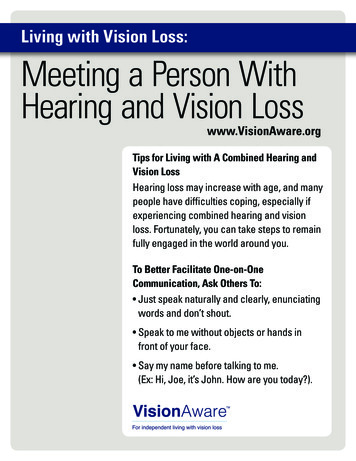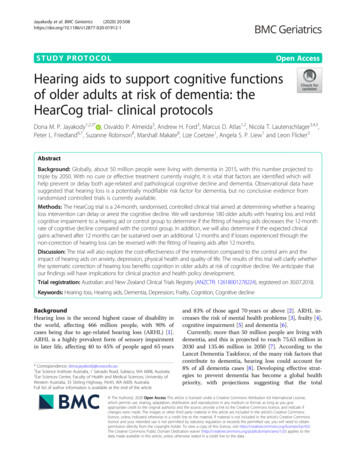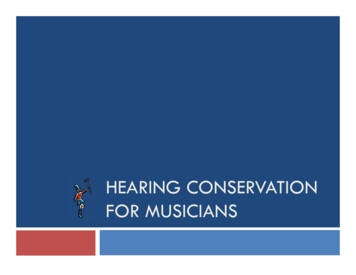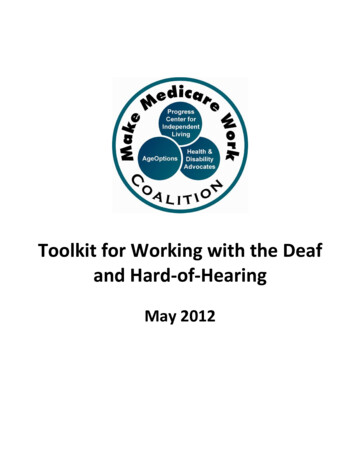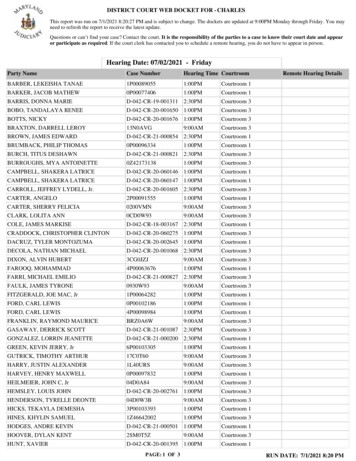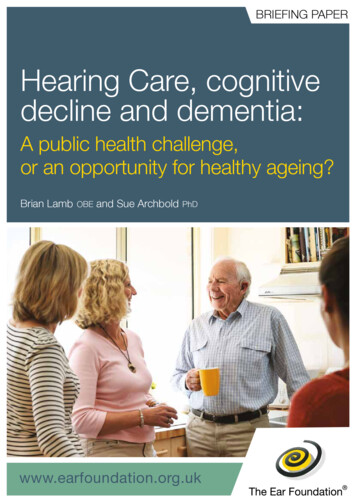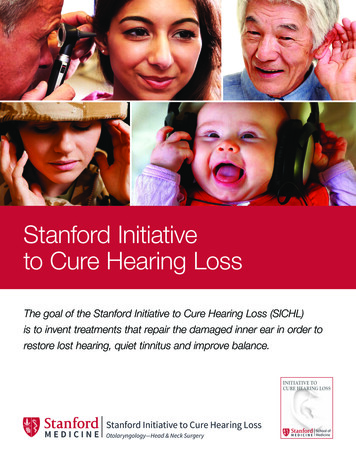
Transcription
STANFORDInitiativeINITIATIVEStanfordTO CURE HEARING LOSSto Cure Hearing LossThe goal of the Stanford Initiative to Cure Hearing Loss (SICHL)is to invent treatments that repair the damaged inner ear in order torestore lost hearing, quiet tinnitus and improve balance.MEDICINEMEDICINEStanford Initiativeto Cure Hearing LossOtolaryngology—Head & Neck SurgeryStanford Initiative to Cure Hearing LossOtolaryngology—Head & Neck SurgeryINITIATIVE TOCURE HEARING LOSSM E D I C I N E School of MedicineSchool ofM E D I C I N E Medicine
The inner ear has two parts: the cochlea for hearing and the vestibular system for balance.Both contain specialized cells, called hair cells, whose purpose is to sense sound and movement.When hair cells become damaged or die, hearing loss, ringing in the ears (tinnitus), or vertigomay result. Today’s medical science offers no solutions for the vast majority of inner ear diseases.Unfortunately, once a hair cell dies, our bodies cannot regenerate it. But here at Stanford, we areworking on solutions that overcome this problem.Hammer, anvil and stirrupEardrum Two out of every 1,000 babies in the UnitedStates are born deaf or hard-of-hearing. Close toa million children in America have hearing loss.Balance canalsCochlea (box)Facial nerveHearing andbalance nerve Health experts estimate that one in three adultsover the age of 65 has developed a debilitatinghearing loss. The numbers continue to increaseas the population grows older. Almost 50 percentof American seniors experience some form ofhearing impairment.Eustachiantube Occupational exposure, amplified music, andmilitary service contribute to hearing loss.Carotid arteryMastoidApproximately 36 millionAmerican adults—17 percent of the entirepopulation—report somedegree of hearing loss.Facial nerveJugular veinThe human cochlea (left)has 2-1/4 turns. The Organ ofCorti (box) is the location of thesound sensing hair cells. Undiagnosed and/or untreated hearing loss inchildren can lead to a delay in spoken languageand can have a significant impact on academicachievement. According to WHO, in developing countries adultswith hearing loss have a much higher rate ofunemployment and a higher percentage of thoseemployed are in lower grades of employment thanthe general workforce. Untreated hearing loss, resulting in less access tovital services and exclusion from social situations,can have a significant impact on everyday life. Lossof hearing can lead to social isolation, lonelinessand frustration, particularly in older adults, and hasbeen linked to an increase in depression. Hair cell dysfunction also causes tinnitus andbalance disorders.Normal Organ of Corti with one row of inner and three rows of outerhair cells.Inset: Organ of Corti in deafness lacks hair cells, but the hearingnerve remains.
FacultyStanford has assembled an interdisciplinary team of scientists, engineers, andphysicians drawing upon expertise from many different domains for the shared purposeof curing hearing loss.By sustaining a research culture that encourages translational medicine—a close interrelationship between basic science investigators and the surgeons and physiciansworking directly with patients—Stanford continues to lay the groundwork for previouslyunimaginable ways to treat and prevent disease.Robert Jackler, MDThe Edward C. and Amy H. SewallProfessor and Chair of Otolaryngology –Head & Neck Surgery and Professorof Neurosurgery and of SurgeryMatthew Fitzgerald, PhDChief of Audiology and Hearing Devicesand Assistant Professor of Otolaryngology –Head & Neck surgeryStefan Heller, PhDThe Edward C. and Amy H. SewallProfessor III in the School of Medicine andProfessor of Otolaryngology – Head &Neck Surgery and of Molecular and CellularPhysiologyNicolas Grillet, PhDAssistant Professor of Otolaryngology – Head &Neck SurgeryNikolas H. Blevins, MDThe Larry and Sharon MalcolmsonProfessor in the School of Medicine andProfessor of Otolaryngology – Head & NeckSurgery and Chief of the Division of Otologyand NeurotologyMirna Mustapha, PhDAssistant Professor of Otolaryngology – Head &Neck SurgeryKay Chang, MDAssociate Professor of Otolaryngology –Head & Neck Surgery and of PediatricsJohn S. Oghalai, MDProfessor of Otolaryngology – Head & NeckSurgery and of PediatricsAlan G. Cheng, MDAssociate Professor of Otolaryngology –Head & Neck Surgery and PediatricsAnthony Ricci, PhDThe Edward C. and Amy H. SewallProfessor II in the School of Medicineand Professor of Otolaryngology – Head& Neck Surgery and of Molecular andCellular Physiology
The Impact of Hearing LossOur ability to communicate is at the coreof what it means to be human, to shareideas, to enjoy friendship, to teach ourchildren. Hellen Keller, who was both deafand blind, had a unique perspectiveabout hearing loss. She said, “Blindnessseparates us from things . but deafnessseparates us from people.”Hearing loss is a huge problem: 5% of the world’s population and 1/3 of seniors over65 experience serious hearing loss. Today people are living longer – they want full lives,and rightly so! Hearing loss can make it impossible to enjoy a restaurant dinner withfamily, an evening at the theater, or even to hear the laughter of children. Hearing loss isa major issue for children as well, affecting nearly 1,000,000 children in the U.S. alone.Hearing loss at birth or early childhood can have a significant impact on speech andlanguage development and without intervention can have consequences for educationas well.What Can We Do to Treat People with Hearing Loss Today?The good news is that with modern microsurgery, we can cure a wide variety of middle ear problems that occurwith the eardrum and its 3 little bones – a big success of 20th century technology.The bad news is that inner ear hearing loss, by far the most prevalent type, remains incurable today.The exciting news is that based upon recent, revolutionary scientific advances, it is clear that hearing loss can becured and we at Stanford are leading the effort.Dispelling the Myth of “Nerve” Deafness:It is a common misconception that hearing loss is due to “nerve deafness.” It is actually from the loss of a tinypopulation of sound sensing hair cells in the inner ear. In humans, damaged hair cells are lost forever – theydo not regenerate. In the early2000’s, the scientific leader ofSICHL, Stanford Professor StefanHeller, became world famous forthe discovery of stem cells in thedeaf inner ear which could becoaxed through clever molecularmanipulations to form new haircells. With his scientific visionand Professor Robert Jackler’sleadership, we assembled theworld’s leading inner ear regeneration team at Stanford.Members of the SICHL Research Team
Where are We Today in Our QuestThe inner ear is a particularly favorable site for regeneration. Most solid organs whichhave failed become a collapsed lump of scar. In the deaf inner ear the architecture ispreserved. The elegant cochlear spiral and the auditory nerve remain intact with only aTherapies: SICHL is capitalizing on Stanford’s network of collaborations to consolidate andadvance promising hearing loss research investigations in four key areas: Stem Cell Therapy,Cellular Reprogramming, Molecular Therapy, and Rebuilding the Normal Vibratory andElectrical Characteristics of the Inner Ear.STEM CELL THERAPY – SICHL researchers are developing biological methods to repair the damaged cochlea byregenerating inner ear hair cells from patients’ own skin or blood cells that have been genetically reprogrammed torevert back to stem cells. Therapies such as these have the potential to restore natural hearing without need for any typeof prosthesis.Concept of Regenerationof Hair Cells by stimulating supportingcells to differentiate into hair cells.Stem Cell SourcesskinPATIENT-DERIVEDSOURCESDamaged sensoryepitheliumfatRegenerated epitheliumStem cellTRANSPLANTSOURCESHair cellblastulaStem cellsumbilical cord bloodConcept of Exogenous Stem CellImplanting in a deaf Organ of Corti toregenerate a hair cell membrane.Stem Cell Transplantation Current hurdles that need to beovercome are efficacy and long term safety.endolymphDamaged inner earperilymphCoaxing surviving inner ear cells to regenerate sensory hair cellsWe are pursuing two strategies that occur naturally in birdsRestored sensory epithelium
to Cure Hearing Loss?small population of hair cells missing. Major strides have been made in regeneratinghair cells in the mouse and connecting them to the hearing nerve. The challenge beforeus is to refine the method and make it safe and effective in humans.CELLULAR REPROGRAMMING – This innovative strategy for restoring hair cells is using genes that orchestrateembryonic development of the cochlea. New-generation harmless virus vectors temporarily introduce these genes.Using a Virus Vector to inserttransformative genetic material intoinner ear cells.MOLECULAR THERAPY – Novel drugs are being developed that could be used either to prevent the cochlea fromlosing hair cells or to initiate a self-repair program within the cochlea. Our researchers are also investigating specifictargets in the inner ear that could be receptive to drug intervention.Concept of Molecular Therapy usingmolecular modulators to transform innerear cells into hair cells.Ototoxicity is a process wherebysome medications cause injury tohair cells resulting in hearing loss.OtotoxicityConcept of Protecting theSensory Epithelium byblocking the toxin receptors.OtotoxicityOtoprotectiveSensory cell deathSensory epitheliumprotectedREBUILDING THE NORMAL VIBRATORY AND ELECTRICAL CHARACTERISTICS OF THE INNER EAR –Stanford researchers are studying how the normal cochlea detects sound pressure waves. The research team haspioneered a new technology, Volumetric Optical Coherence Tomography Vibrometry, which permits non-invasiveimaging within the cochlea. By studying normal-hearing and hearing-impaired animal models, researchers hope toimprove speech recognition abilities for hearing-impaired patients.A. Normal hearingB. Frequencies blurringC. Frequencies sharpened
A High Probability of SuccessA Moonshot to Seek a Cure for Hearing LossWould Have a High Probability of Success:When speaking of his moonshot, President Kennedysaid we should do it, “.not because it is easy, butbecause it is hard.a challenge we are willing toaccept.”Here at Stanford, we feel the same way about ourmoonshot to cure hearing loss. We have compelling reasons to believe that our goalhas an exceptional chance for success. Hearing loss, tinnitus and imbalance are majorcauses of human disability which we believe, can be conquered.Dr. Robert Jackler, Department ChairWhy is Stanford Best Prepared to Discover a Cure?Stanford is a special place with unique characteristics which foster innovation and discovery. We are highlycollaborative and enjoy a high degree of intellectual exchange – Expertise flows throughout the campus.We attract scientists and engineers from various disciplines to bring their methods to hearing research. AtStanford, our hearing scientists are part of a clinical department, which creates a laser focus on overcominghuman disease.Great ideas require not only inspiration but also great execution. We have over 100 researchers including faculty,scientists, students and technicians currently working to reach this goal and bring a cure into clinical trials.Why You May Want to Support Hearing Regeneration Research:Rapid advances in bioscience and technology, many of which originated at Stanford, make it realistic to envisiona cure within the foreseeable future. In laboratory animals, we can now regenerate inner ear hair cells, a tantalizing accomplishment, which we are working hard to adapt for human benefit.In our moonshot to regenerate the inner ear, we have reached earth orbit and need a substantial boost toreach the moon. An investment in hearing regeneration research today is likely to have a tremendous return oninvestment – the prospect of categorically curing one of man’s most common disabilities.How to Participate – Gifts to SICHL can be made in several ways:ONLINE – Make a gift by visitinghearinglosscure.stanford.edu andclicking on the “make a gift” linkBY MAIL OR FAX – Print and completethe online donation form and return itwith your gift to:Otolaryngology – Head & NeckSurgery c/o Development ServicesPO Box 20466Stanford, CA 94309650-725-2450 (fax)CALL US – Contact MedicalCenter Development by calling650-725-2504 to discuss a giftFor further information on theStanford Initiative to Cure HearingLoss, please visit our website:hearinglosscure.stanford.edu
Accelerating Our Quest for a CureWe are seeking philanthropic partners to help accelerate our progress. Donor support will allow us to recruitthe best and brightest researchers, to acquire more cutting-edge laboratory technology, and to pursue highrisk/high reward investigations. These strategies will enable us to arrive at a cure in the shortest possible time.The question is not if, but when. Will a baby girl born with hearing loss today benefit from this cure as a toddler, a teen, as a young adult?Government grants are important – and we do very well in getting them – but they are not sufficient. Federalgrants tend to fund incremental research, but not necessarily the most imaginative and visionary proposals.Both private and public support is needed if we are to accelerate our quest to invent a cure. Philanthropic support today can be leveraged by helping to reset the national research priorities.Opportunities to Invest in Curing Hearing LossReaching our ambitious goal will only be possible through partnerships with visionary donors. We invite you tojoin other like-minded philanthropists by making your investment in SICHL.Giving Opportunities Include: Seed Grant Funds – These funds fuel pilot projects that can prove our innovative approaches.Gifts for seed grants can be leveraged to garner long-term federal grant support. Technology and Laboratory Funds – Access to the highest quality equipment expedites our researchand enables our scientists to pursue the most creative experiments. Facilities – Our goal is to move all the SICHL labs into a new,state-of-the-art building by 2019 to facilitate collaborationwithin the team and with other related disciplines suchas neuroscience, genetics and stem cell biology. Namingopportunities will be available for donors. Faculty Support – Endowed or expendable gifts to enablerecruitment of talented researchers to join SICHL and to allowour research faculty to focus on high-risk, high-reward projectsof the type needed for major discovery. Trainee Support – These funds provide specialized multi-yeartraining in the field of hearing loss research, creating the nextgeneration of world-class scientists.Dr. Stefan Heller, SICHL Research DirectorStanford InitiativeStanford Ear Institute:RobertK. Jackler,to Sewall Professor and ChairFor further information on theStanford Initiative to Cure HearingLoss, and updates on the research,please visit our r the latest updates, join us via:Medical Center EDICINEKate MorrisInitiative eadNeck Surgery –Department of&OtolaryngologyHead and Neck nford Initiative to Cure Hearing LossOtolaryngology—Head & Neck Surgery
Hearing loss is a huge problem: 5% of the world’s population and 1/3 of seniors over . 65 experience serious hearing loss. Today people are living longer – they want full lives, and rightly so! Hearing loss can make it impossible to enjoy a restaurant dinner with family, an evening
